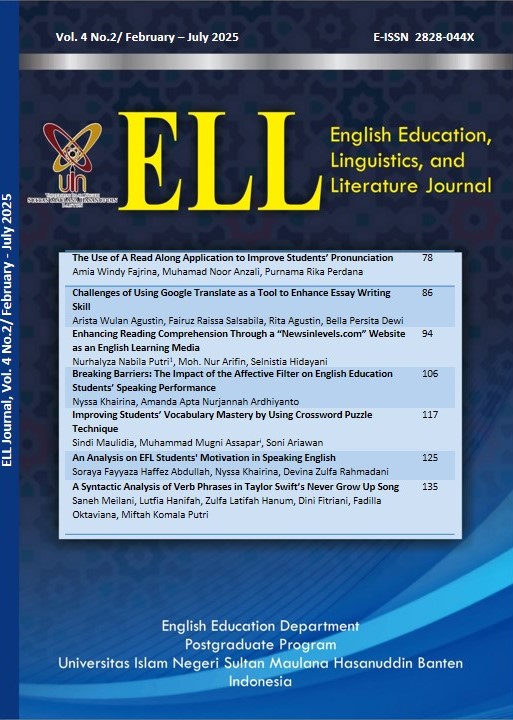The Use of A Read Along Application to Improve Students’ Pronunciation
DOI:
https://doi.org/10.32678/ell.v4i2.11249Keywords:
Pronounciation, Read Along applicationAbstract
This study aims to enhance students' English pronunciation skills through the use of the Read Along application. The research focused on seventh-grade students at SMPN 2 Cilegon during the 2023/2024 academic year. The participants were 34 students from class VII B. The methodology employed was Classroom Action Research (CAR) as developed by Kemmis and McTaggart, conducted in two cycles each consisting of planning, action, observation, and reflection. Data collection involved both qualitative and quantitative methods. Qualitative data was gathered using observation sheets, while quantitative data was obtained through tests. The application usefulness was hampered in cycle I initial test by problems like slow internet connectivity and low student participation. The first was for the students to open the application, which they did without any problems. However, only about 20% of students were able to grasp the second level's features. This was due to the students' inexperience with the technology of the application, which made it take longer for them to get used to. With an average score of 62.41, only 6 students (17.65%) passed the Minimum Completion Criteria (KKM). After resolving these issues, demonstrated significant improvements in the second test of cycle II, there was significant improvement, with 29 students (85.30%) meeting the Mastery Minimum Criteria (KKM) and an average score of 82.05. The study concludes that the Read Along application is effective in improving the English pronunciation of seventh-grade students at SMPN 2 Cilegon.
Downloads
References
Ahmad, Yousef Bani, ‘Problems and Strategies in Teaching Pronunciation on English
Department Students’, JUDIKA (Jurnal Pendidikan Unsika), 7 (2019), 57–62
Alelaimat, Ali M., Fathi M. Ihmeideh, and Mustafa F. Alkhawaldeh, ‘Preparing
Preservice Teachers for Technology and Digital Media Integration: Implications for
Early Childhood Teacher Education Programs’, International Journal of Early
Childhood, 52.3 (2020), 299–317 https://doi.org/10.1007/s13158-020-00276-2
Juliardi, Dede, Endang Susilawati, and Eusabinus Bunau, ‘An Analysis of Students’
Pronunciation Mastery of Dental Fricative and Alveolar Plosive Sounds’, Journal of
Equatorial Education and Learning, 2019, 6
Laila, Inna Nur, and Ayunita Leliana, ‘English Pronunciation of English Department
Students of UNESA Segmental and Suprasegmental Perspective’, ELite Journal :
International Journal of Education, Language, and Literature, 2.2 (2022), 2022
https://journal.unesa.ac.id/index.php/elite
Maylia Arina, Neneng, and Taufan Dayu Islamiah, ‘The Teaching of Speaking Using
Storytelling’, Proceeding of Shepo (International Conference On Social Sciences &
Humanity, Economics, And Politics), 2020 (2020), 63–66
Palupi, Dian, Evi T Prasetyaningsih, and Sayyidah Bilandari, ‘Improving Young
Learners’ Pronunciation Skill Through Songs’, ETERNAL (English Teaching
Journal), 13.1 (2022), 21–31 <https://doi.org/10.26877/eternal.v13i1.10512>
Paul, Salvin, ‘The Palgrave Encyclopedia of Global Security Studies’, The Palgrave
Encyclopedia of Global Security Studies, March, 2020 <https://doi.org/10.1007/978-
-319-74336-3>
Reader, Perangkat Natural, ‘The Use of Natural Reader Software in Teaching’, 5.1
(2020), 21–31
Siti Khasinah, ‘CLASSROOM ACTION RESEARCH’, Pioneer: Journal of Language
and Literature, 1 (2013), 107–14
Starkey-Perret, Rebecca, ‘Gerald Kelly, How to Teach Pronunciation’, Les Cahiers de
l’APLIUT, 2008, pp. 112–14 <https://doi.org/10.4000/apliut.1350>
Downloads
Published
Issue
Section
License
Copyright (c) 2025 Amia Windy Fajrina, Muhamad Noor Anzali, Purnama Rika Perdana

This work is licensed under a Creative Commons Attribution-ShareAlike 4.0 International License.






